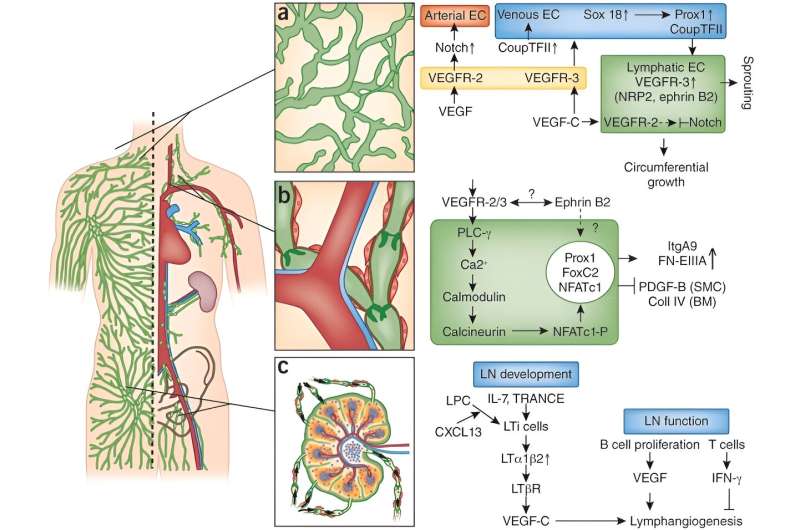This article has been reviewed according to Science X's editorial process and policies. Editors have highlighted the following attributes while ensuring the content's credibility:
fact-checked
peer-reviewed publication
trusted source
proofread
Q&A: New lymphedema-on-chip platform holds promise

In a new PNAS study co-authored by Boston University biomedical engineer Dr. Chris Chen, researchers say they're getting closer to understanding the mysteries of lymphedema—a condition characterized by the buildup of fluid in the body due to a malfunctioning lymphatic system. Until now, the reasons behind this disorder have remained elusive.
As part of the study, the research team created a tiny 3D cell culture model that mimics the function of lymphatic vessels. They used this model to explore how certain inflammatory substances in our bodies, called cytokines, affect the lymphatic system. Surprisingly, these cytokines didn't weaken the connections between lymphatic cells, as expected.
Instead, they made them tighter, causing problems with fluid drainage out of tissues. But here's the exciting part: the researchers also found a way to counteract these effects. By targeting a protein called ROCK2, the team managed to reverse lymphedema in mice. Dr. Chen, director of BU's Biological Design Center, shares how this discovery opens up new possibilities for treating the condition and future applications for other diseases.
What is the primary goal of this research study?
The goal of this work was to develop a platform to study how lymphatic vessels drain fluid that accumulates in tissues, and then use it to see if we could understand why lymphatic drainage is reduced when they experience injury-induced inflammation, leading to lymphedema (edema, or swelling of tissues, caused by lymphatic dysfunction). Ultimately, we discovered a pathway that causes this to happen, and showed that lymphedema can be improved by inhibiting that pathway first in our device and then in mice.
What is lymphedema and why is it important to study it?
Lymphedema is a debilitating chronic condition that impacts millions of people, where fluid that naturally and continuously leaks into tissues from blood vessels, is not being drained sufficiently by the lymphatics. It can be painful and significantly increases the rates of infection of the affected tissue or organ. In the US, one of the more common causes of lymphedema is following surgeries or radiation such as for treating gynecologic or breast cancer.
What did the researchers discover about lymphatic vessels during injury?
Using the lymphatic-on-chip device, we found that inflammatory cues commonly release during injury can cause the vessels to decrease fluid drainage. Examining how this happens, we discovered that cells tighten their cell-cell junctions, which closes the space between them and prevents fluid from passing through. They appear to form these tight junctions using a receptor known as JAM-A, and inhibiting ROCK2 prevents this, allowing drainage to continue.
What are the potential future applications of this research beyond lymphedema treatment?
Going forward, we are hoping to understand what other changes occur in the lymphatics following injury, and more generally understand how to restore their function. Fluid drainage is important not only for lymphatics, but in many more general cases where tissues retain fluid (edema), such as pulmonary edema from COVID-19 infection.
How might this study contribute to bridging the gap between laboratory research and real-world medical applications?
We hope that these organ-on-chip models engineered to mimic human pathologies continue to help provide a new way to study and ultimately cure human diseases.
Who are the key research collaborators?
Dr. Hong Chen and Dr. Diane Bielenberg both contributed to the work. They are professors at the Boston Children's Hospital and Harvard Medical School, and experts in lymphatic vascular biology. Dr. Esak Lee led the study as a postdoctoral fellow in my group and is now an assistant professor at Cornell University.
More information: Esak Lee et al, A 3D biomimetic model of lymphatics reveals cell–cell junction tightening and lymphedema via a cytokine-induced ROCK2/JAM-A complex, Proceedings of the National Academy of Sciences (2023). DOI: 10.1073/pnas.2308941120
Journal information: Proceedings of the National Academy of Sciences , Nature Medicine
Provided by Boston University





















